Korean Independence Movement Day is a national holiday. The campaign to liberate Korea from Japan began in 1910 and came to a head on March 1st, 1919. Many citizens took a peaceful stand against the Japanese occupation on this date. It was a show of unified strength and resistance against Japanese rule.
Today it is called 삼일절 Sam-iljeol, literally meaning 3-1 Festival Day, or March 1st Movement Day. On that day in 1919, 33 Korean Movement cultural and religious activists read the Korean Declaration of Independence, followed by over 2 million Koreans participating in over 1500 demonstrations throughout the next 12 months. Before the Japanese government could stop them, approximately 7,000 Koreans were killed, 16,000 wounded, 763 homes and churches were destroyed by fire, and 46,000 people arrested. While the movement did not immediately gain independence as they had hoped, it did eventually lead to the birth of the Korean Provisional Government.
I appreciate the significance of the day for the country, and I was happy that we got a four-day weekend! Sam-iljeol took DanFam5 north.
❅⛄ Alps Village ⛄ ❅
South Korea is very densely populated; the population is about 1300 people per square mile, whereas the US is slightly under 100. On top of that, Korea is roughly the size of Indiana yet 70% mountainous, so 52 million people are crammed into quite a small area. That being said, they can't afford to let occupied land go to waste.
The 칠갑산 Chilgapsan Mountain along the western coast has earned the nickname the Alps of 충청남도 Chungcheongnam-do. In 2008 the tiny town had dwindled to just 200 occupants. Like many other areas in SoKo, the people of the community got together and discovered a way to bring people and economics back to their village. They came up with seasonal festivals to bring tourism and life back to their community.
Unfortunately we were too late in the season to experience the Ice Festival. We did, however, get to view the incredible ice fountains,
the snow sculptures,
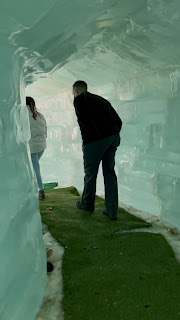

and the ice caves. In her prime, that was Elsa between the two cave entrances.


There were famous landmark snow sculptures, like the Christ The Redeemer statue from Brazil,
and the Sydney Opera House.


Here are the kings of the castle igloo, warming up the throne.
The creepy girl from Squid Game made an appearance.


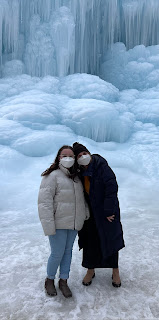







These snow sculptures hit closer to home. The building in the middle is N Seoul Tower, sitting next to a hareubong from Jeju Island.
The dokkaebi goblin (the mascot for my kids' house team at school) proudly sits beside a traditional Korean temple.


I don't know how they create these huge ice fountains, but because the temperature is warming up and they are beginning to melt, we caught a glimpse of the process with a few little fountains spewing water out of the tops.
The actual festival has a plethora of activities to accompany the fountains and sculptures, along with traditional Korean snacks. One such snack that still happened to be offered was roasted chestnuts picked from the nearby Chilgapsan Mountain. Every time I see them being sold, I sing, "🎵 Chestnuts roasting on an open fire...🎶 " I usually sing it to myself because the children get very embarrassed when I sing in public, but that doesn't always stop me.
I'm not one to post pics of food, but we found a yummy Mexican restaurant named Don Pablos. Not the same US chain, but still deliciouso, or 맛있어요 masisseoyo. 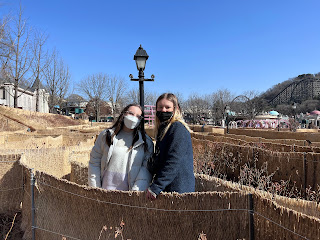
한국민속촌 Korean Folk Village was constructed in 1974 with the intent of presenting and preserving the Korean culture that has been passed down over the centuries.  Across 243 acres lies over 260 traditional houses from the late Joseon Dynasty (the late 1800s). These are authentic structures relocated from provinces all over the country from people of different social classes. They include 한옥 hanok (traditional houses) of both aristocrats and commoners, 서완 seowon
Across 243 acres lies over 260 traditional houses from the late Joseon Dynasty (the late 1800s). These are authentic structures relocated from provinces all over the country from people of different social classes. They include 한옥 hanok (traditional houses) of both aristocrats and commoners, 서완 seowon
🏯 ⛩ Wawoojeongsa Temple ⛩ 🏯
I was able to sneak the family in to tour 와우정사 Wawoojeongsa Temple before check-in at the hotel because we had some time to kill. This group has had their fill of temples, so you gotta be sneaky to get them to see any more, but I pulled it off.
Nestled among the 48 peaks of the 연와산 Yeonhwasan Mountain range, Wawoojeonsa Temple (sometimes called the Waujeongsa or Wowjeongsa Temple) houses more than 3,000 Buddhist statues imported from India, Myanmar, Sri Lanka, China and Thailand. Seen as a symbol of hope for world peace as well as displaying Buddhist cultures from all around the world, many foreign tourists visit the temple in addition to Korean nationals.
The giant 불다Bulda (Buddha head) is the first thing to greet you as you approach. Proudly standing at 8m high, it is the largest of its kind.
This piece of driftwood contains trinkets and coins that have been pressed in the creases by visitors.I could not find the significance of this owl statue listed anywhere, and it doesn't quite match the overall vibe, but isn't it cute? Wawoojeongsa is one of Korea's youngest temples, established in 1970 by a Buddhist monk named 해왈봅라 Haewolbopsa. He was displaced from North Korea during the war. Wawoojeongsa happens to be the birthplace of the Korean Buddhist Nirvana Order, but the true motivation and hope for Haewolbopsa was the unification of the two Koreas through the merits of Buddha.
Wawoojeongsa is one of Korea's youngest temples, established in 1970 by a Buddhist monk named 해왈봅라 Haewolbopsa. He was displaced from North Korea during the war. Wawoojeongsa happens to be the birthplace of the Korean Buddhist Nirvana Order, but the true motivation and hope for Haewolbopsa was the unification of the two Koreas through the merits of Buddha.

The alligator and crane are in the pond that sits in front of the big Bulda head.
This little dude is a new addition over the past couple years. It was made in Nepal and brought to Korea. It is Buddha's Birth Statue, because Nepal is Buddha's birth country. Several hundred Nepalis residing in Korea contributed donations toward this as a gift.
Dharma Daishi was an enlightened Hindu from India. He is credited with reviving the Hindu philosophy in China. According to Chinese legend, this second teacher (following Buddha himself) is said to have began the training that led to kungfu. Take a look at his crazy eyes and you can see he definitely wants to kick someone's a**.
Worshippers attach their prayers to these lotus trinkets that are available for purchase.
Doesn't this little dude look happy?

Reunification Pagoda has been created from stones donated from various sacred Buddha grounds all around the world.

Even though it's called Reunification Pagoda - singular - there are actually several pagodas.



I love the relationship my boys have. They talk and laugh and make up creative stories and really enjoy each other's presence.
This Buddha is also a donation from the Nepalese people and is relatively new.
There are two of these mean looking guys on each side of the stairs leading to the Hall of Nirvana. Vajra Warriors are often placed at the entrance of temples because they are seen as guardian figures of life and death. As such, they are thought to guard from evil spirits and shelter good spirits.

삭야무니불고항상 Sakyamuni Bulgohangsang statue is a bronze Buddha sitting with his legs half-crossed. It is the largest of its kind in Korea. Sakyamuni was an Indian prince turned monk and became the founder of Buddhism.
This was donated by the Thai royal family in memory of the Thai soldiers who lost their lives in the Korean War. It is 5.4 meters high and weighs 10 tons.
Yaksa Nyorai Buddha is probably the name of this statue. He was the Buddha associated with healing.

This semi-circle of stone statues are called the 500 Nahan. Nahan means enlightened being, or one who is worthy, and they were the original disciples of Shakyamuni, similar to the equivalent of a Christian saint. Buddha asked the Nahan to "remain in the world to propagate Buddhist law, to protect and benefit the common beings, and extend human lives." They are traditionally depicted in groups of 16, 18, or 500 for some significance, kind of like there were the 12 disciples.
A long mural called 팔상도 Palsang-do depicts the eight scenes from Buddha's life. These scenes include: 1-elephant (announcement of birth), 2-baby (birth), 3-sick or dead man (the world outside the palace), 4-white horse over a wall (renunciation), 5-starved figure (asceticism), 6-tempsters (temptations), 7-halo (enlightenment and teaching) and 8-bier (death and nirvana).
This building, called 대각전 Daegakjeon, was impressive with its large pillars and domed roof. 비천 Bicheon, heavenly maidens offering gifts, were painted on the dome ceiling.

It was dark in here; we illuminated this figure made of white jade stone with our phone light. It's an ascetic statue of Sakyamuni, depicting how he appeared after 6 years of fasting. It was a little creepy. Probably why it happens to be the nation's only Sakamuni Bulgohangsang statue (which I think means Buddha in his ascetic state).
These little stone pagodas, called the Tower of Wishes, have the look of Tapsa Temple. 

The twelve zodiac statues proudly stand in front of the main hall.
They have been decorated with masks and scarves by visitors.
This dude is the Maitreya Banga, or the Future Buddha. He resides in heaven and according to Buddhist belief, will reappear in 5.6 billion years in the future. It is suggested he looks contemplative because he has been waiting for such a long time. This is the largest bronze Future Buddha statue in the country.
This statue was carved from a rock retrieved from the sea, according to one site. It might be 수월관음 Suwol Gwaneum, which was a water-moon deity worshipped for her ability to prevent calamities and diseases, and to safeguard travelers on their journey.
The opening of the 1988 Seoul Olympics were announced by the ringing of the Reunification Bell. It weighs 12 tons and is claimed to be the largest gold bell, finding its permanent home here.
Jizo Bosatsu is the name of this statue. It is known as the protector of children, expectant mothers, firemen and travelers. Most of all, he is the protector of deceased children, including miscarried, aborted, or stillborn infants.
Jizo Bosatsu is the name of this statue. It is known as the protector of children, expectant mothers, firemen and travelers. Most of all, he is the protector of deceased children, including miscarried, aborted, or stillborn infants.
No description needed for this one.
The world's largest Reclining Buddha, carved from a giant Chinese Juniper tree imported from Indonesia, is on the grounds. It is registered in the Guinness Book of World Records. Because darkness was upon us, and a storm was rolling in, we didn't get to see it. My little meteorologist had her finger in the air, detecting the wind direction and predicting the oncoming precipitation. We barely made it out of the parking lot when the rain hit.

*Full disclosure: this info may not be 100% accurate. It is hard to find websites in English and the translation app doesn't always get things totally accurate. Not all the sites agree, either. So basically I'm asking for a little grace if someone ever notices something is off.😉
🎡 🎢 Everland Theme Park🎢 🎡
The next stop was Korea's first and largest theme park. Opened in 1976 as Yongin Farmland, the theme park has hosted more than 257 million visitors--on average, the entire nation of South Korea has been to the theme park more than five times each!
Global Fair is the first area, where there are various architectural features from around the world, along with various souvenir shops.

As we entered the American Adventure zone, we hooked up with our friends the Gludsteds, who were in Seoul for the weekend and scooted on down to meet us at Everland. So fun!
 |
| Trish, Zeke, Daisy, Astrid, Julius, Lotte |
The American Adventure zone is based on 500 years of American History, from the time when Columbus arrived on the continent to the time when Elvis arrived on the rock-n-roll scene.

 |
| The whole gang--Abe, Zeke, Lotte, Julius, Karoline, Martin Eli, Trish, Daisy, Astrid |
Zootopia was designed to create a harmonious bond between humans and animals. We did not realize that this part of the park was so popular; by the time we got here the wait lines were craaazy long, so we skipped the safari part, which looked pretty amazing.
 Across 243 acres lies over 260 traditional houses from the late Joseon Dynasty (the late 1800s). These are authentic structures relocated from provinces all over the country from people of different social classes. They include 한옥 hanok (traditional houses) of both aristocrats and commoners, 서완 seowon
Across 243 acres lies over 260 traditional houses from the late Joseon Dynasty (the late 1800s). These are authentic structures relocated from provinces all over the country from people of different social classes. They include 한옥 hanok (traditional houses) of both aristocrats and commoners, 서완 seowonand 서당 seodang (educational instututions), 한약방 hanyakbang (traditional medical institutions), 선낭당 seonangdang (religious buildings) and 관나 gwana (provincial government offices).
The goal of the village was to provide an open-air learning place to 'convey the wisdom and spirits of our ancestors for generations to come.'
We were supposed to witness how life in the typical village was settled, how the space was divided between habitants of various professions, what were the main annual events in their lives and how they were celebrated. Truth be told, we didn't. I read that there was an audio tour available for purchase, but I never saw where to get it. We were deep inside the village before I remembered that I wanted the audio. So we didn't actually learn as much as I was hoping to learn.
Old mill stones are seen all over Korea. The base is stationary and the top part, or the runner stone, is what does the grinding as it is moved around the bedstone.
A traditional game of 투호 tuho consists of throwing arrows into a pot.


Administrative missions called 콰나 kwana were carried out in the Provincial Governor's Office. Many official matters, including city administration, military, justice, taxation, and construction duties were handled. This governor's office contained the main office, the inner living quarters, and the jail in the back.When they ask Daddy for a treat, next time he better get it!




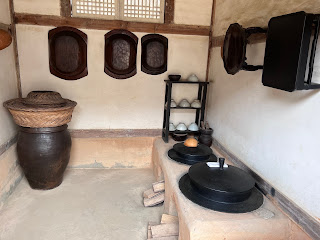











We we able to see 농악 nongak, which is famer's music and dancing that was performed during planting and harvesting.


This was a dance of the working class. "Nongak is not only used to alleviate the farmers' fatigue and pain, but it is also used as a ritual for the god, or in a battle field to expel the enemy. In the end, nongak is by nature a progressive act combining group desire, and an art of revival and survival to overcome pain with enthusiasm."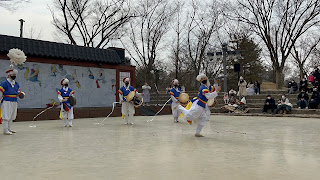
This dude was dancing and spinning a plate on a stick. He came right over to us, seated in the front row, and in a pause in the music he said, "Hello." People laughed because he spoke English to the 미국migooks (Americans).

The Nangak was performed around 장승 Jangseung such as these. After the performance, the townspeople ate, drank and danced together.


This is a seowon, which is a school.
This was a noble scholar's house, which shows the scholar's thrifty lifestyle.








The village's guardian deity is called 서낭당 Seonangdang, and a shrine to him was a sacred tree located in the village. 오방천 Obangcheon was tied to the tree as a means of escaping from misfortune, with blue representing the east, white for the west, red for the south, black for the north, and yellow for the center.

































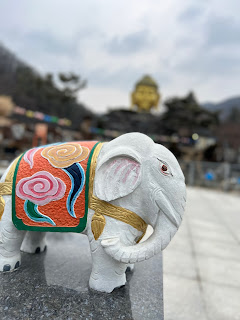






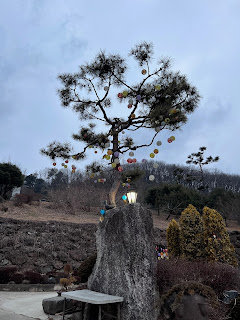












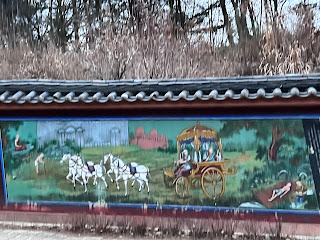





























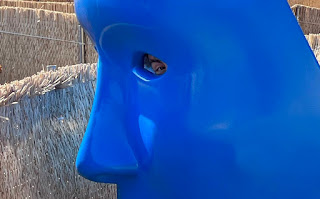




























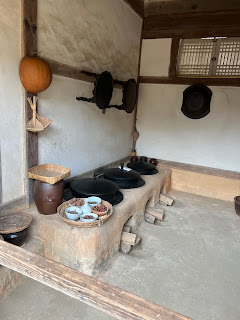






















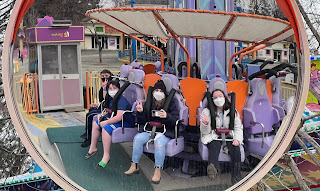




No comments:
Post a Comment